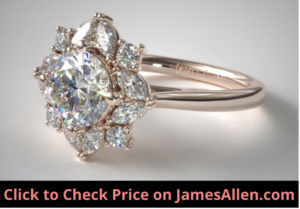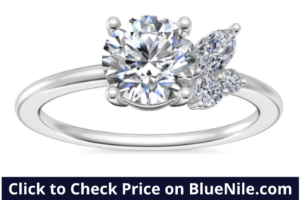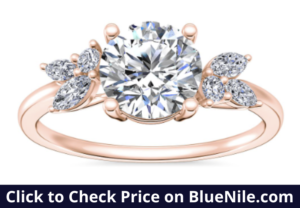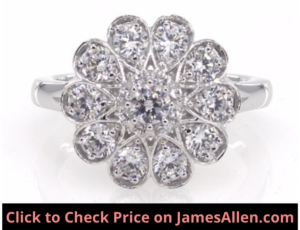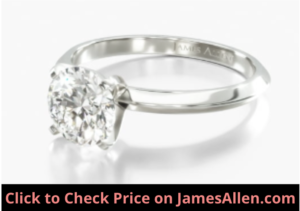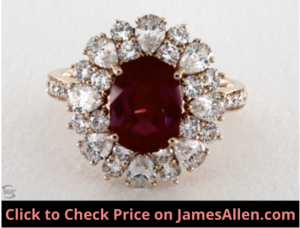- By Jacob Clarke
- jacob.clarke@teachjewelry.com
- Last Updated: November 1, 2023
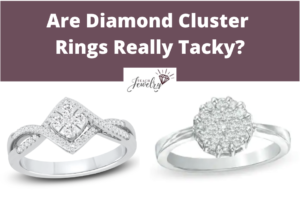
Whether you’re searching for a piece of jewelry for a proposal or another special occasion, there are always styles that rise and fall in popularity.
One design you might consider is a diamond cluster ring.
But there’s concern cluster rings are tacky because they’re an alternative to the classic version featuring a single diamond on top.
In this article, I’ll explain what you need to know about diamond cluster rings, why they’re sometimes viewed as tacky, and how to know whether it’s the right choice for you.
What is a Cluster Ring?
Cluster rings include several diamonds placed closed together to mimic the appearance of a single gem.
In many cases, all the diamonds are the same size. Other designs have a larger diamond in the middle that’s surrounded by several small ones.
The intent is often for someone to view the diamond and perceive that it’s a solitaire setting with a heavy diamond. Instead, the total carat weight (CTTW) is spread across five to 10 diamonds.
Cluster rings also vary in their designs by combining cuts.
Take this cluster halo diamond in 14K rose gold.
The center diamond is a round-cut, but its halo is made of marquise cuts.
They’re clustered together in a way that allows the marquise cuts to complement the center diamond instead of blend in with it. In total, it creates.a floral design.
In other cases, they’re clustered on one side, like in the asymmetrical ring below.
Notice how the ring isn’t balanced. There are multiple diamonds to the right of the main one, but none to the left or on top or bottom.
It’s these styles that can cause cluster diamond rings to earn the reputation as appearing tacky, as opposed to the elegant aesthetic of a solitaire setting.
Pros
If you’re worried a diamond cluster ring could be viewed as tacky, there are several pros to choosing one. Here are three to consider.
Popularity
The first is they’re increasing in popularity.
I analyzed search data from Google dating back to 2009 and found more buyers are searching for cluster rings in recent years.
This chart from Google Trends shows that interest peaked in 2021 and has generally been on an upward trajectory the last decade.
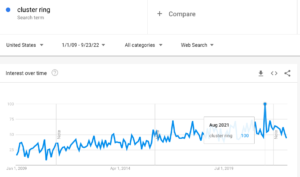
This demonstrates how despite concerns related to cluster rings, more buyers are interested in them than ever before.
Less Expensive
Another appeal is they’re less expensive than solitaire settings. The price of diamonds doesn’t increase linearly. Instead, it’s exponential.
So a 1.5-carat diamond costs more than three diamonds that weigh 0.5 carats.
Cluster diamond rings reduce cost by featuring smaller diamonds.
I’ll provide a real-world example.
This cluster setting includes four marquise cut diamonds with a CTTW of 0.17.
It costs $1,850.
If I instead chose to increase the carat weight of the round-cut diamond in the middle by 0.17 carats, it would cost far more than that.
To illustrate, here’s a one-carat diamond that costs $5,700.
This diamond earned the same color, cut, and clarity grades but weighs 1.17 carats. Its price is $9,570.
That’s a difference of $3,870 for 0.17 carats, which is $2,020 more than the cluster setting.
So you’ll save money by selecting a cluster setting over solitaire.
They’re even less expensive if all the cluster diamonds are small, as opposed to one slightly larger that’s surrounded by other.
Variety
Another advantage of cluster rings is there are a variety of designs that often form a geometric shape like a circle, flower, or square.
To illustrate, the setting below features four round-cuts that are most prominent in the center.
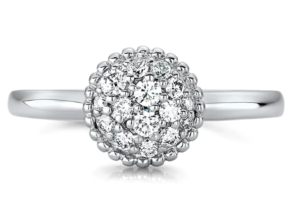
But they’re surrounded by many more for a tight, cohesive aesthetic.
The style below is shaped like a star, with pear-cut diamonds pointing toward a round-cut in the middle.
Whether you want a simple style full of round-cut diamonds or one that incorporates fancy shapes, there are an endless number of designs for cluster diamond rings.
Cons
There are also cons to choosing a cluster diamond ring.
While these downsides don’t always cause them to appear tacky, they’re worth considering as you explore the right piece for you.
Doesn’t Align with Tradition
The first disadvantage is it’s not viewed as a standard engagement ring that aligns with tradition.
Engagement rings often feature one diamond that’s prominent, like in the setting below.
Although there can be other gems on the piece, like a halo surrounding the center gem or pave lining the shank, it’s expected that these rings include a single large diamond.
Cluster rings often deviate from this expectation by displaying several small diamonds.
If you’re interested in the prestige of owning a large diamond or want to show off its rarity, it’s best to opt against a cluster setting.
But if you choose one, consider a piece that offers the illusion of a single stone as opposed to one where there are multiple cuts.
Repairs and Maintenance
Cluster rings are also difficult to clean, maintain, and repair.
It’s easier for dirt to trap under multiple small diamonds compared to a single one. You’ll have to clean it regularly to ensure each maintains its sparkle.
As an example, here’s a cluster ring with a sapphire at its center.
There are 24 round and pear-cut diamonds surrounding it, and debris can lodge between each one.
You can clean most jewelry by soaking it with mild dishwashing detergent, but be mindful of your jeweler’s instructions for your specific piece.
Additionally, repairs are challenging because of how many small diamonds are on the ring. They’re liable to fall out, and it’s tedious work for a jeweler to replace it because of how tightly they fit together.
Some of these issues can be avoided by choosing a cluster setting with a lower number of diamonds.
Opt for one with fewer than 10 gems compared to designs featuring more than 20.
If one loosens, you’ll have an easier time finding a professional to replace it.
How to Avoid Your Cluster Ring Appearing Tacky
If you’re concerned your choice in cluster ring could appear tacky, here are some guidelines to consider.
Aesthetic
First, opt for a cluster ring with a cohesive aesthetic. When diamonds of the same cut are placed closely together, they blend together in a way that looks natural.
At a quick glance, viewers won’t notice there are multiple stones on the piece.
It’s only when viewed up close that someone will notice its elegant details.
Avoid too Many Cuts
My second tip is to avoid too many different cuts. While it’s common to have a round-cut diamond complemented by a fancy shape, this can cause the ring to appear disjointed.
The example below fits this category.
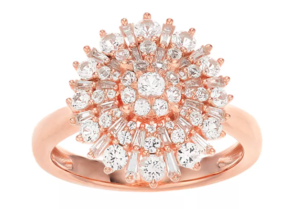
There are five layers, and it includes round and baguette cuts.
Although it was designed with intricate details, that many levels of diamonds reduces its simplicity and could cause it to be considered tacky.
Focal Point
Lastly, it’s common for a diamond ring to have a focal point. In solitaire settings, it’s the center diamond.
Even styles with accents are generally designed to focus on the main gem. The other diamonds on the piece, whether pavé or channel set, add brilliance without distraction.
My recommendation is to choose a cluster setting that has a single point that draws your eye in, even if there are several diamonds on top.
Is a Cluster Ring Right For You?
Cluster rings aren’t tacky, but they aren’t the right choice for everyone.
If you’re interested in an alternative to a traditional engagement ring, they’re often less expensive while still offering the potential of a stunning piece.
Here are some questions you can ask to learn if a cluster setting is right for you:
- Is the idea of a large, prominent diamond on the ring important to you?
- Are you interested in saving on price compared to a solitaire setting?
- Do you want an engagement ring that aligns with tradition?
Your answer to those questions can guide your decision to choose a cluster diamond ring or another design.
Either way, you’ll land on the right piece of jewelry for you.

Jacob Clarke
Jacob Clarke is the founder of TeachJewelry.com.
He earned an Applied Jewelry Professional Diploma from the Gemological Institute of America (GIA) and now brings you essential information about diamonds, settings, and more.
Jacob has consulted with leading jewelry brands, and his work has been cited in Clean Origin, Diamond Nexus and industry publications.
He's also a member of the International Gem Society.
He enjoys discussing jewelry with readers, so contact him with any questions at jacob.clarke@teachjewelry.com.

